Figures & data
FIGURE 1. A, simplified composite phylogenetic tree depicting possible relationships among the Pseudocrenilabrinae, based on Schwarzer et al. (Citation2009) and Dunz and Schliewen (Citation2013). B, strict consensus phylogenetic tree illustrating possible relationships within the ‘East African Radiation’; tree was compiled using the ‘compute consensus’ option of PAUP. Sources: Neighbor-joining consensus tree based on mitochondrial and nuclear genetic data (amplified fragment-length polymorphism [AFLP]; Weiss et al., Citation2015:), and maximum likelihood tree based on mitochondrial and nuclear genetic data (Meyer et al., Citation2015:fig. S1); only nodes with a bootstrap support >50 were considered. Abbreviations: ATM, ancient Tanganyika mouthbrooders; MATT, most ancient Tanganyika tribes; M-Orthochromis , Malagarasi Orthochromis from the rivers Malagarasi, Luiche, and Rugufu; LML-Orthochromis , Orthochromis from the Luapula-Mweru system and the Lualaba/Congo system; NZ-Orthochromis , northern Zambian Orthochromis from northern Zambia; see Weiss et al. (Citation2015) and Meyer et al. (Citation2015) for further explanations. Lineages that include riverine taxa are depicted in purple font. The blue frames encompass tribes endemic to Lake Tanganyika (except for the riverine group within the Lamprologini). The red frame encloses all lineages of the Haplochromini. C, illustration of a generalized cichlid depicting all morphometric measures (arrows) used in this study. Abbreviations: BL, body length; h, minimal body height; H, maximal body height; H2, body height at origin of anal fin; lA, length of anal fin base; lC, length of caudal fin; lD, length of dorsal fin base; lpc, length of caudal peduncle; lV, length of pelvic fin; lVbs, length of pelvic fin base; V–A, distance between pelvic fin origin and anal fin origin.
![FIGURE 1. A, simplified composite phylogenetic tree depicting possible relationships among the Pseudocrenilabrinae, based on Schwarzer et al. (Citation2009) and Dunz and Schliewen (Citation2013). B, strict consensus phylogenetic tree illustrating possible relationships within the ‘East African Radiation’; tree was compiled using the ‘compute consensus’ option of PAUP. Sources: Neighbor-joining consensus tree based on mitochondrial and nuclear genetic data (amplified fragment-length polymorphism [AFLP]; Weiss et al., Citation2015:fig. 3), and maximum likelihood tree based on mitochondrial and nuclear genetic data (Meyer et al., Citation2015:fig. S1); only nodes with a bootstrap support >50 were considered. Abbreviations: ATM, ancient Tanganyika mouthbrooders; MATT, most ancient Tanganyika tribes; M-Orthochromis , Malagarasi Orthochromis from the rivers Malagarasi, Luiche, and Rugufu; LML-Orthochromis , Orthochromis from the Luapula-Mweru system and the Lualaba/Congo system; NZ-Orthochromis , northern Zambian Orthochromis from northern Zambia; see Weiss et al. (Citation2015) and Meyer et al. (Citation2015) for further explanations. Lineages that include riverine taxa are depicted in purple font. The blue frames encompass tribes endemic to Lake Tanganyika (except for the riverine group within the Lamprologini). The red frame encloses all lineages of the Haplochromini. C, illustration of a generalized cichlid depicting all morphometric measures (arrows) used in this study. Abbreviations: BL, body length; h, minimal body height; H, maximal body height; H2, body height at origin of anal fin; lA, length of anal fin base; lC, length of caudal fin; lD, length of dorsal fin base; lpc, length of caudal peduncle; lV, length of pelvic fin; lVbs, length of pelvic fin base; V–A, distance between pelvic fin origin and anal fin origin.](/cms/asset/7b1761bc-13c7-4284-9e6f-7333ec1b54f3/ujvp_a_1297819_f0001_oc.gif)
TABLE 1. Eocene to Pliocene fossil cichlid species from Africa and Arabia that are based on articulated skeletons and their putative phylogenetic placement according to the literature.
←FIGURE 2. †Tugenchromis pickfordi, gen. et sp. nov. A1–A2, holotype in part (OCO-5-35) and counterpart (OCO-5-22); A3, right lateral view of the specimen (shading refers to ribs from the left side of the specimen); B1, caudal skeleton of †T. pickfordi, gen. et sp. nov. (OCO-5-22); B2, reconstruction of caudal skeleton in left lateral view. Abbreviations: cl, cleithrum; cor, coracoid; ep, epural; hs, hemal spine; hyp, hypural plate; lac, lacrimal; nlc, neurocranial lateral line canal; ns, neural spine; o, otolith; op, operculum; ph, parhypural; pha, pharyngeal teeth; ppc, postcleithrum; ptt, posttemporal; pu, preural centrum; rad, radials; sca, scapula; scl, supracleithrum; sop, suboperculum; us, urostyle; un1, uroneural 1; = , tubular lateral line scale; °, pitted lateral line scale.
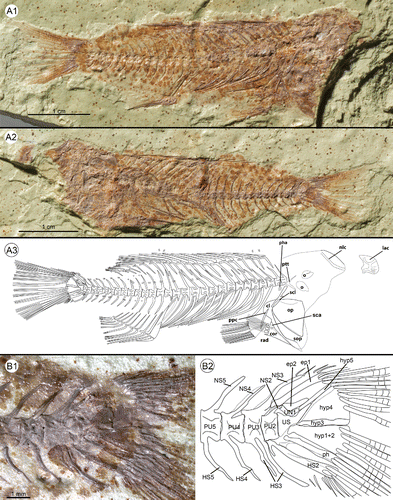
←FIGURE 3. A1–C, part and counterpart of the caudal portion and complete reconstruction of †Tugenchromis pickfordi, gen. et sp. nov., showing the pattern of the three lateral line (trunk canal) segments. A1–A2, segment of the posterior trunk canal extending below the vertebral column and also below the anterior canal segment (OCO-5-35); B1–B2, additional segment of the posterior trunk canal above the vertebral column (OCO-5-22); B3–B4, close-up views of pitted and tubular lateral line scales. C–E, tripartite lateral line pattern in Ectodini and the new fossil cichlid. C, †T. pickfordi, gen. et sp. nov.; D, Grammatotria lemairii; E, Xenotilapia sima. Arrows indicate the three trunk canal segments. Panels D and E modified from Boulenger (1899).
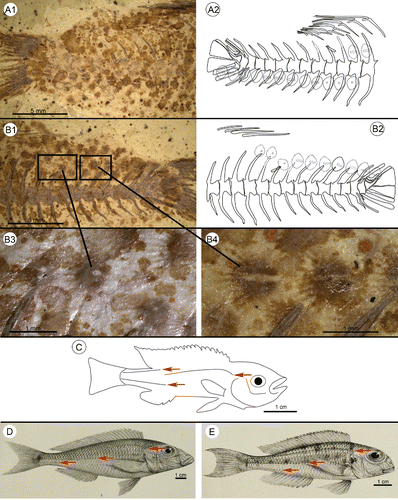
TABLE 2. Morphometric measurements and meristic counts of †T. pickfordi.
FIGURE 4. A1–A2, lacrimal of †Tugenchromis pickfordi, gen. et sp. nov. (OCO-5-22), showing the lateral line branched into six tubules; B, lacrimal of cf. Pelmatochromis spp. (redrawn after Van Couvering, Citation1982); C–F, SEM images of pharyngeal teeth of †T. pickfordi, gen. et sp. nov. (OCO-5-22); C, hook-like unicuspid tooth with shoulder; D, simple unicuspid tooth; E, simple unicuspid tooth; F, hook-like unicuspid tooth with shoulder; G1–H2, scales of †T. pickfordi, gen. et sp. nov.; G1–G2, flank scale with 13 radii (OCO-5-35); H1–H2, lateral line scale with tubular opening on peduncle; circuli are also discernible (mirror image; OCO-5-22). The arrows point anteriorly.
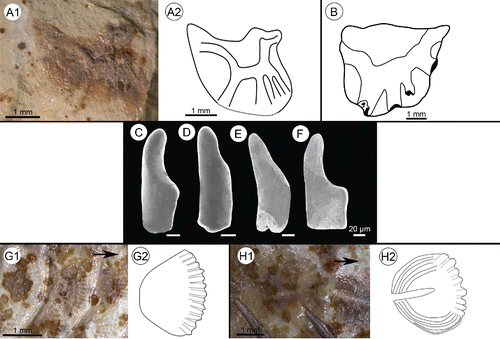
FIGURE 5. Principal coordinates analysis (PCoA) scatter plot based on nine meristic characters of †Tugenchromis pickfordi, gen. et sp. nov., and the four major cichlid groups of the ‘East African Radiation,’ indicated with different symbols and colors (N = 764; see Supplementary Data 2 for raw data). Species score limits are visualized as 95% confidence ellipses. Coordinate 1 vs. Coordinate 2. Coordinate 1 explains 50.96% and Coordinate 2 explains 36.85% of the variation.
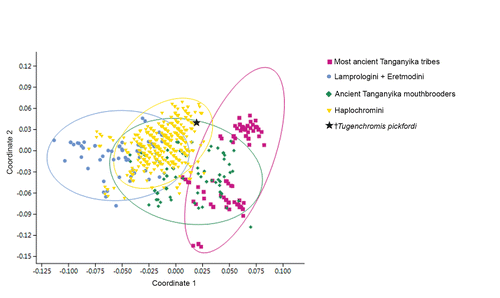
←FIGURE 6. Meristic counts, scale types, and lacrimal morphology of †Tugenchromis pickfordi, gen. et sp. nov., and representatives of all cichlid lineages of the ‘East African Radiation.’ Meristic counts from this study (see Supplementary Data 2), Weber (Citation1897), Trewavas (Citation1935, Citation1964, Citation1983b), Greenwood (Citation1956a, Citation1956b, Citation1957, Citation1959, Citation1960, Citation1962, Citation1967, Citation1973, Citation1979, Citation1980, Citation1989, Citation1993), Greenwood and Gee (Citation1969), Greenwood and Barel (Citation1978), Hoogerhoud and Witte (Citation1981), Witte and Witte-Maas (Citation1981), Poll (Citation1986), Winemiller and Kelso-Winemiller (Citation1991), Bowers and Stauffer (Citation1993), Stauffer and Van Snik (Citation1996), Stauffer et al. (Citation1997), De Vos and Seegers (Citation1998), De Zeeuw et al. (Citation2000), Black (Citation2010), Oliver and Arnegard (Citation2010), and Konings and Stauffer (Citation2012). Note that some of these publications do not specify whether the total/caudal count of vertebrae includes the urostyle or not. Scale type from this study and Poll (Citation1986). Lacrimal morphology from this study (A, J, N–S), Cichocki (Citation1976) (T), Liem (Citation1978) (M), Oliver (Citation1984) (V, W), Anker (Citation1986) (U), and Takahashi (Citation2003a) (B–I, K–L). Species from which lacrimals are illustrated are indicated by capital letters: A, †T. pickfordi (OCO-5-22); B, Ectodus descampsi Boulenger, Citation1898; C, Greenwoodochromis christyi (Trewavas, Citation1953); D, Xenochromis hecqui Boulenger, Citation1899b; E, Eretmodus cyanostictus Boulenger, Citation1898; F, Variabilichromis moorii (Boulenger, Citation1898); G, Bathybates minor Boulenger, Citation1906; H, Lobochilotes labiatus (Boulenger, Citation1898); I, Benthochromis tricoti (Poll, 1948a); J, Cyphotilapia sp. (ZSM 043240_(P-AA-0999)); K, Cyprichromis microlepidotus (Poll, Citation1956); L, Trematocara marginatum Boulenger, Citation1899a; M, Boulengerochromis microlepis (Boulenger, Citation1899a), scale bar for lacrimal not known, TL of specimen 16 cm; N, Orthochromis malagaraziensis (David, Citation1937) (ZSM 041469_(DRC-2011+1029)); O, Orthochromis stormsi (Boulenger, Citation1902) (ZSM 042318); P, Orthochromis sp. Mambilima (ZSM uncatalogued specimen); Q, Orthochromis torrenticola (Thys van den Audenaerde, Citation1963) (ZSM 038201_(Uli-LUB 2008+008)); R, Orthochromis machadoi (Poll, Citation1967) (BMNH 1984.2.6.116-131_2); S, Haplochromis vanheusdeni Schedel, Friel and Schliewen, Citation2014 (ZSM 043134); T, Pseudocrenilabrus philander (Weber, Citation1897); U, Haplochromis elegans Trewavas, Citation1933; V, Maylandia (Pseudotropheus) zebra (Boulenger, Citation1899c); W, Serranochromis macrocephalus (Boulenger, Citation1899b). Abbreviations: ATM, ‘ancient Tanganyika mouthbrooders’; lacr., lacrimal; LML-Orthochromis , Luapula-Mweru system and Lualaba/Congo Orthochromis; #Lt, number of lateral line tubules on the lacrimal; M-Haplochromini, Haplochromini of Lake Malawi; M-Orthochromis , Malagarasi Orthochromis; MATT, ‘most ancient Tanganyika tribes’; n.a., not available; NZ-Orthochromis , northern Zambian Orthochromis; R-Haplochromini, riverine Haplochromini; V-Haplochromini, Haplochromini of Lake Victoria. All scale bars equal 5 mm.
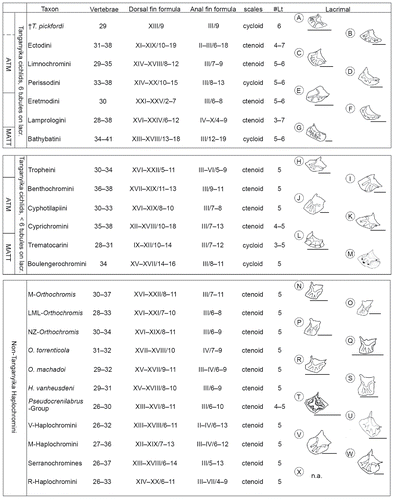
FIGURE 7. Putative phylogenetic position of †Tugenchromis pickfordi, gen. et sp. nov., within the East African Radiation based on possible synapomorphies shared with some of the extant lineages of the haplotilapiines. Shared osteological and scale character states are indicated in red, shared meristic character states are shown in purple; filled/unfilled rectangles mean character state is shared/not shared between †T. pickfordi and the given extant lineage. A, phylogenetic relationships of the East African Radiation (EAR) within the haplotilapiines, as shown in ; B, the character state ‘lacrimal with six lateral line tubules’ (character A) results in the position of †T. pickfordi, gen. et sp. nov., as extinct lineage within the ‘most ancient Tanganyika tribes’ (MATT); C, the combination of the character states ‘lacrimal with six lateral line tubules’ (character A), ‘cycloid scales’ (character B), and ‘presence of tripartite lateral line’ (character H) results in the position of †T. pickfordi, gen. et sp. nov., as stem lineage of the ‘ancient Tanganyika mouthbrooders’ (ATM). Trees shown in B and C are constructed based on the neighbor-joining consensus tree of Weiss et al. (Citation2015:fig. 3); ancestral states for nodes were assembled based on the characters A–J using the parsimony reconstruction in Mesquite 3.11 (Maddison and Maddison, Citation2016).

TABLE 3. Summary table of relevant characters of the fossil specimen and all previously described African, Saudi Arabian, and European fossil cichlids, where at least some of these characters are preserved.
